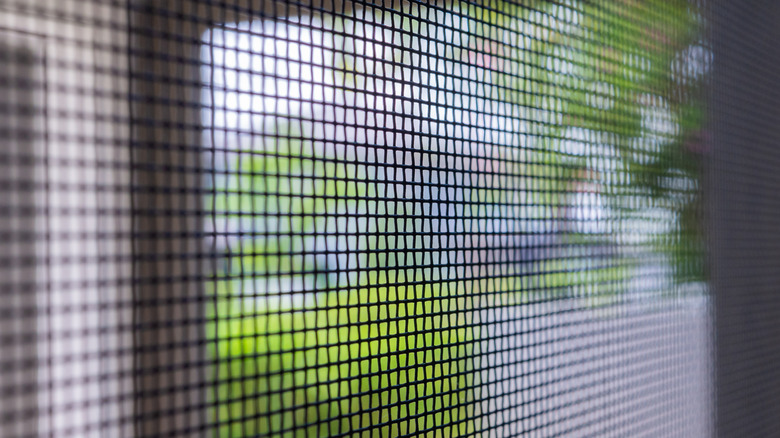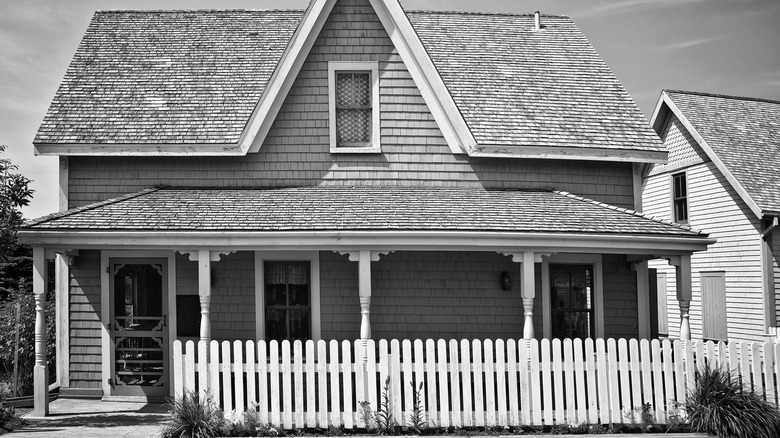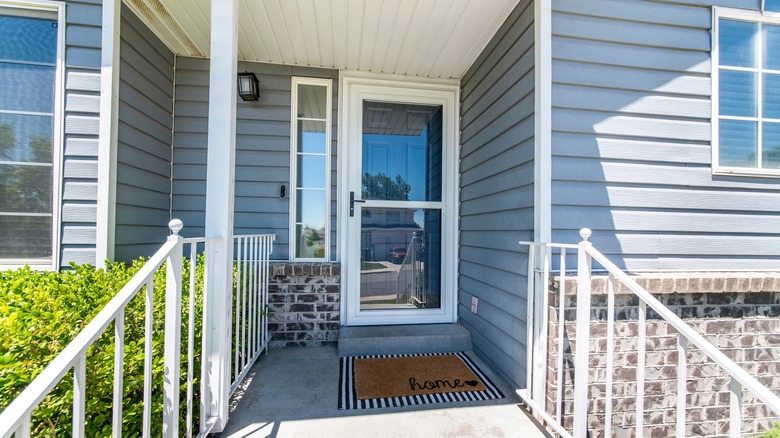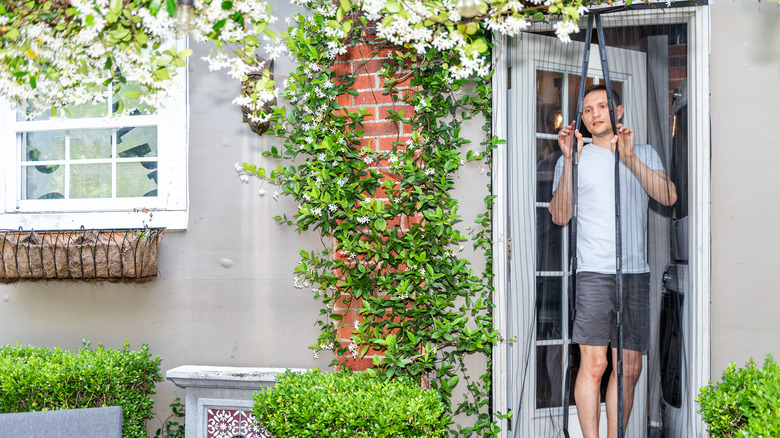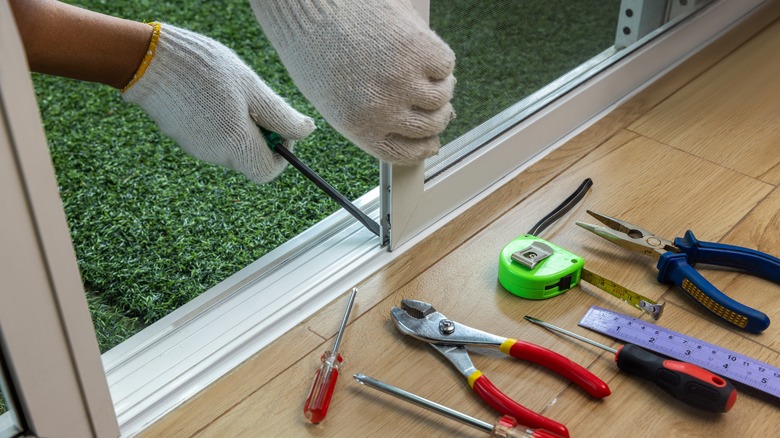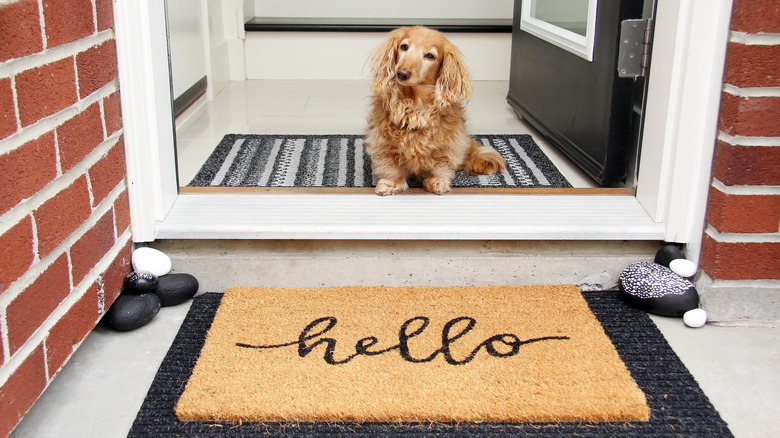5 Types Of Screen Doors To Help You Pick The Right One For Your Home
Installing a new screen door can be a complicated task. This isn't because the screen door itself is difficult to utilize, but rather because there are so many different types of screen doors that a homeowner can choose from. Screen doors are an important structural component in a well-designed home as they give you the ability to flush the inside of your home with fresh air while still protecting the space from debris that may be in the air, pests that might find their way inside, or other, similar problems that can occur when leaving your door wide open. Triple Pundit notes that this can improve energy efficiency as well.
A screen door is easy to use and gives you the ability to bring all the best parts of the outdoors into your home in a controlled manner. Screen doors are typically added in tandem with your existing door and used in combination. But the various types of doors that homeowners have available to them can make the selection process a little bit tricky. The traditional screen door is always a good call, but it may not be the right type for all applications. Considering these five types can help you get the best experience in your home possible while bringing in the perfect type of door for your home's environment.
1. The traditional screen door
The traditional screen door is likely going to be your first port of call. It makes use of hinges and an opening mechanism that is essentially the same as a standard door (via WCMA Net). For most homeowners, installing a front door that opens inward is the norm, and the screen door will simply sit on the outside face and swing toward the exterior of the property. To use this type of door, you'll open the screen door and then proceed to open the door leading into your home.
A standard screen door gives you easy access into and out of your property with minimal added consideration. As well, it incorporates a tiny footprint, making it an easy-to-add feature that also looks great on any home. Screen doors are an immensely common feature and the traditional model that uses timber or aluminum framing and paneling, and simple (or perhaps intricate) screen designs will elevate the look and feel of your home. This is also the easiest way to start bringing a waft of fresh air into your interior space for a much-needed pick-me-up at any time of the day.
2. A storm door
Storm doors are critical for homeowners living in hurricane-prone areas and other parts of the country that see immense rainfall, wind, and other excesses of weather intensity. Storm doors come with thick glass panes and high-quality and high-strength materials to round out the securitization of your property. However, a storm door can also be outfitted in many instances with screen adaptations (via Andersen Windows & Doors). Typically, the storm door makes use of one or more large glass segments that allow you to see directly through it. But in areas that see a mix of intense weather patterns and wonderfully serene spring or summer days, a door that's only designed to keep the weather out can be a blight on your day-to-day happiness and routine.
A storm door that allows for a transformation into one providing a screen surface is a great option for homeowners in this type of situation. They give you the best of both worlds, allowing you to protect your home during the worst parts of the year in terms of weather forecasts, and infuse a natural sense of the outdoors into the interior of your home when the weather is much nicer. Storm doors are a great security measure for homeowners in vulnerable areas, but one that allows for customizations and flexibility can be a uniquely beneficial option.
3. Magnetic screen doors
Magnetic screen doors are a cool option for homeowners who like easy access to exterior spaces and a technologically advanced aesthetic to their property. This type of door makes use of two screens that sit parallel to one another vertically. With a break in the middle, you can walk freely through this screen. The midpoint is connected with magnets that are easy to pull apart and swing effortlessly back into position once you've passed through the doorway (via Oregon Live and JRESHOW). This is great for homeowners who love to entertain in outdoor spaces. Instead of having to prop open the screen door as you walk back and forth from the kitchen to bring snacks, drinks, or plates of food outside, a magnetic screen door provides a hands-free option that will continuously reclose itself after you've stepped through it.
The magnetic option is also good for homeowners with young children. Children love playing outside, and on a hot summer day will often be found running in and out of the house. With a magnetic screen door, you can leave the main door open to allow a breeze to flow through into the home and experience a worry-free afternoon, without the potential for a slammed screen door to break in the process. These magnetic doors are a great innovation and can make for a simpler lifestyle and a sleek look.
4. Sliding screens
Sliding screens are another option that homeowners can take advantage of. A sliding screen door is often installed in a space with a large opening out into a back patio or elsewhere, but can be used in single-door setups, too. Sliding doors are simply the go-to choice for homeowners with double doors leading to an exterior decking space or even a wraparound porch. French doors are a wonderfully luxurious option in many homes, and taking a page from this book by incorporating sliding doors can give you the best of both worlds. A large opening that makes use of two or more door segments is an easy way to beautify your property, and with a sliding screen door complementing this egress point, it's easy to bring in fresh air and sunlight on a daily basis.
Sliding doors work with a track that runs on the top and bottom of each door segment. Instead of opening with a hinge, sliding doors sit inside this track and make use of small wheels or bearings to provide a free-flowing movement between closed and open positions (via Money Pit). This means that the hardware involved is mostly hidden, giving you a luxurious opening without all the bulky gear that comes along with other door options. Sliding doors require additional maintenance, however, because their track can become clogged with debris and the mechanisms may be susceptible to rust and other grit.
5. Pet screen additions
For a homeowner with pets, there is nothing quite like a screen door that incorporates a pet entryway near the bottom. Instead of chopping a hole in your wall or forgoing the screen door altogether in order to keep your pet door on an existing exterior entryway, a screen door that includes a space for your pet to transition from the inside to the outside is a great alternative solution. K9 of Mine also reports that many homeowners have trouble with pets bursting through lower sections of screen enclosures. A pet doorway on the screen itself can solve this problem as well.
Pet screen doors are constructed in a similar manner to the typical pet entryway. However, the material is made of or designed to integrate with the same mesh screening that you would use for a more traditional screen door. Attaching one of these options to a section of your patio space can give you the ability to close your dog or cat in the home when necessary, and allow them to wander freely between the outdoors, an enclosed patio, and the inside areas of your property seamlessly and without you having to intervene.
